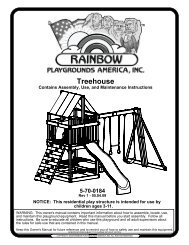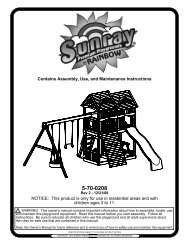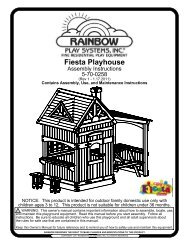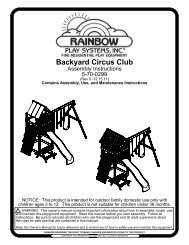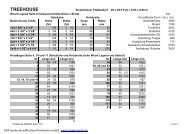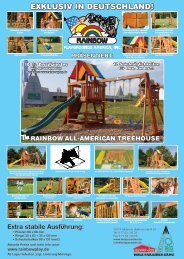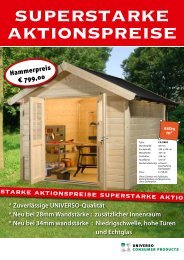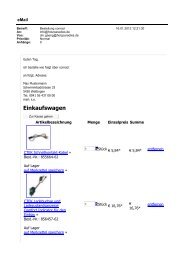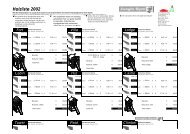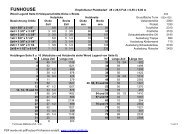Carnival Castle
Carnival Castle
Carnival Castle
Create successful ePaper yourself
Turn your PDF publications into a flip-book with our unique Google optimized e-Paper software.
10. On a yearly basis, we recommend that you coat your play system with a sealant or preservative. You may<br />
also want to spot sand areas before sealing. Be sure that the sealant you select is non-toxic and child safe.<br />
11. At the beginning of each usage season, check all wood members for deterioration and splinters. Spot<br />
sand any areas that are checking or splintering. If parts are deteriorating, replace as needed.<br />
PILOT<br />
HOLES<br />
WARNING<br />
Drilling, sawing, sanding or machining wood products generates wood dust,<br />
a substance known to the State of California to cause cancer. Avoid inhaling<br />
wood dust or use a dust mask or other safeguards for personal protection.<br />
California Health and Safety Code Section 25249.6<br />
Helpful Installation Hints<br />
*NOTE: Refer to these assembly tips throughout the entire installation process.<br />
1. After thoroughly reading all information and properly locating your play system site, carefully<br />
unpack parts. As you unpack your play system, keep the parts list handy and become familiar with each<br />
part before beginning assembly. Remember that a little extra time spent familiarizing yourself with the parts<br />
and instructions before you begin will help avoid mistakes and save you time later.<br />
2. Group both wood and non-wood parts together in accordance to each page, or Step, of this assembly<br />
manual. Doing this now will help you quickly locate parts and assemble the set with ease.<br />
3. Sort your hardware into groups of similar hardware pieces. Use a solid surface, such as the empty boxes,<br />
to ensure you do not lose any hardware.<br />
4. Before starting each Step, thoroughly read all of the instructions to ensure all information is understood.<br />
Pay special attention to the orientation of each part, details & notes, and proper usage of hardware. Each<br />
piece of hardware is required for a certain part of the assembly.<br />
5. Certain Steps of the assembly are best performed on a hard flat surface to ensure proper and accurate<br />
assembly.<br />
6. All Lag Bolts must have pre-drilled holes 2" deep (as shown in Detail A). Use a 1/8" drill bit for all<br />
1/4" and 5/16" Lag Bolts and use a 1/4" drill bit for all 3/8" Lag Bolts. Lag Bolts can be difficult to put<br />
in knot holes. Pre-drilling pilot holes will help to prevent the Lag Bolts from breaking. Refer to<br />
"Commonly Asked Questions" on page 6 for more information about Lag Bolts.<br />
7. All #14 Phillips Pan Head Tap Screws must have pre-drilled holes 1/2" deep. Use a 1/8" drill bit.<br />
8. Use a clamp to secure Facias flush to the Uprights and use holes in facia as a guide for placing Lag<br />
Bolt Pilot Holes (as shown in Detail B).<br />
9. Verify Facias are flush with Uprights.<br />
10. Check assembly periodically to ensure the set is level and all facias are square to the uprights.<br />
11. If a gap occurs between boards when inserting Screws or Lag Bolts, back out hardware and apply<br />
pressure to the top board while reinserting hardware in the same hole.<br />
USE FACIA AS<br />
A GUIDE FOR<br />
PRE-DRILLING<br />
UPRIGHT<br />
HOLES<br />
DETAIL A<br />
FACIA<br />
FACES MUST<br />
BE FLUSH<br />
5<br />
DETAIL B



